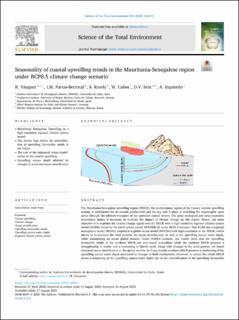| dc.contributor.author | Vázquez, R. | |
| dc.contributor.author | Parras-Berrocal, I.M. | |
| dc.contributor.author | Koseki, Shunya | |
| dc.contributor.author | Cabos, W. | |
| dc.contributor.author | Sein, D.V. | |
| dc.contributor.author | Izquierdo, A. | |
| dc.date.accessioned | 2023-12-15T13:38:53Z | |
| dc.date.available | 2023-12-15T13:38:53Z | |
| dc.date.created | 2023-10-12T14:04:08Z | |
| dc.date.issued | 2023 | |
| dc.identifier.issn | 0048-9697 | |
| dc.identifier.uri | https://hdl.handle.net/11250/3107838 | |
| dc.description.abstract | The Mauritania-Senegalese upwelling region (MSUR), the southernmost region of the Canary current upwelling system, is well-known for its coastal productivity and the key role it plays in enriching the oligotrophic open ocean through the offshore transport of the upwelled coastal waters. The great ecological and socio-economic importance makes it necessary to evaluate the impact of climate change on this region. Hence, our main objective is to examine the climate change signal over the MSUR with a high resolution regional climate system model (RCSM) forced by the Earth system model MPI-ESM-LR under RCP8.5 scenario. This RCSM has a regional atmosphere model (REMO) coupled to a global ocean model (MPIOM) with high-resolution in the MSUR, which allows us to evaluate the wind pattern, the ocean stratification, as well as the upwelling source water depth, while maintaining an ocean global domain. Under RCP8.5 scenario, our results show that the upwelling favourable winds of the northern MSUR are year-round intensified, while the southern MSUR presents a strengthening in winter and a weakening in March–April. Along with changes in the wind pattern, we found increased ocean stratification in the spring months. In those months southern MSUR presents a shallowing of the upwelling source water depth associated to changes in both mechanisms. However, in winter the whole MSUR shows a deepening of the upwelling source water depth due to the intensification of the upwelling favourable winds, with the increased ocean stratification playing a secondary role. Our results demonstrate the need to evaluate the future evolution of coastal upwelling systems taking into account their latitudinal and seasonal variability and the joint contribution of both mechanisms. | en_US |
| dc.language.iso | eng | en_US |
| dc.publisher | Elsevier | en_US |
| dc.rights | Attribution-NonCommercial-NoDerivatives 4.0 Internasjonal | * |
| dc.rights.uri | http://creativecommons.org/licenses/by-nc-nd/4.0/deed.no | * |
| dc.title | Seasonality of coastal upwelling trends in the Mauritania-Senegalese region under RCP8.5 climate change scenario | en_US |
| dc.type | Journal article | en_US |
| dc.type | Peer reviewed | en_US |
| dc.description.version | publishedVersion | en_US |
| dc.rights.holder | Copyright 2023 The Author(s) | en_US |
| dc.source.articlenumber | 166391 | en_US |
| cristin.ispublished | true | |
| cristin.fulltext | original | |
| cristin.qualitycode | 2 | |
| dc.identifier.doi | 10.1016/j.scitotenv.2023.166391 | |
| dc.identifier.cristin | 2184157 | |
| dc.source.journal | Science of the Total Environment | en_US |
| dc.identifier.citation | Science of the Total Environment. 2023, 898, 166391. | en_US |
| dc.source.volume | 898 | en_US |

